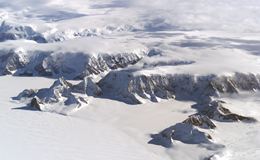Warming ocean is biggest driver of Antarctic ice shelf melt, says new study

Larsen Ice Shelf, NASA
Of earth's two vast ice sheets, Antarctica is perhaps the more mysterious. From the icy surface to the ocean below, there are several different ways the ice sheet is shrinking. How these processes compare is key to knowing how fast melting ice sheets are raising sea levels worldwide - and a new study out today may help to shed a bit more light.
Ice sheets and sea level rise
There is huge scientific interest in monitoring how the ice sheets are changing because when ice on land melts it drains into the ocean, causing sea levels to rise.
Last week, we reported on a major review of how scientists' understanding of ice sheet melt has advanced since the last Intergovernmental Panel on Climate Change (IPCC) report in 2007.
But while Greenland is relatively well understood, at the other end of the planet in Antarctica the picture is a little less clear, the report concludes.
Antarctic ice shelves
To understand how most of the ice is lost from Antarctica, a new study just published in the journal Science looks to the ice shelves that surround 75 per cent of the continent.
Ice shelves are floating extensions of land ice that act as buttresses, stopping ice flowing from the interior straight out into the ocean.

Ice shelves line 75 per cent of the Antarctic coastline. The biggest ones are the Ross and Ronne-Filchner ice shelves, marked here in red and dark blue. Source: National Snow and Ice Data Centre
Traditionally, scientists thought large chunks of solid ice breaking off the ice shelves was the main source of ice loss from Antarctica - a process known as iceberg calving.
But there's another way. As the ocean below the ice shelves warms, the ice melts from the bottom up - something scientists call basal melting. With melting from the top and bottom, some ice shelves are getting noticeably thinner, says the new study.
Bottom-up melting
The paper looked at both processes of ice loss across 99.5 per cent of Antarctica's ice shelves between 2003 and 2008. Overall, the scientists found basal melting caused 55 per cent of ice loss, although they saw quite a lot of variation between regions.
This makes bottom-up ice shelf melt the largest source of ice shelf loss in Antarctica, the paper suggests. Previous studies have estimated the contribution to be more like 30 per cent, or even as low as 10 per cent.
Calling the new findings "a game changer", lead author on the paper, Professor Eric Rignot from the University of California Irvine, explains what this means for scientists' understanding of the ocean surrounding Antarctica - the Southern Ocean. He tells us:
"[T]he role of the Southern Ocean in controlling the evolution of ice shelves, thereby the evolution of the ice sheet as a whole, is more significant than estimated previously. This places more emphasis on understanding the evolution of the state of the Southern Ocean".
The scientists found smaller ice shelves melted more than large ones. Giant ice shelves like the Ross, Filchner and Ronne occupy two thirds of the total ice shelf area but accounted for just 15 per cent of melting. Half of the meltwater came from 10 smaller ice shelves occupying just eight per cent of the total area.
An uncertain ice sheet
If Antarctica melted completely, scientists estimate it could add about 58 metres to global sea level. At the moment, satellite data indicates the Antarctic ice sheet is losing ice but only at a rate of about 0.2 mm per year - more than three times slower than Greenland.
That's partly because different parts of the ice sheet are changing in different ways. Even though ice shelves in West Antarctica and the Antarctic Peninsula are melting and breaking apart, this doesn't contribute directly to sea level rise as they are already floating on water.
But their thinning accelerates ice flow from the many glaciers in the continent's interior, which does raise sea levels. Warmer air overlying the ice also causes melting on the surface.
Nearly half of the ice shelves In East Antarctica are thinning too, according to the new paper. But satellite data indicates the mass of ice in East Antarctica is growing overall thanks to an increase in snowfall.
But scientists warn there are still lots of uncertainties about these estimates. So monitoring the contribution of different processes - and how they're likely to change in the future - is critical for producing reliable projections of sea level rise.
Rignot et al., (2013) Ice shelf around Antarctica. Science DOI: 10.1126/science.1235798
Material is licensed under a Creative Commons Attribution No-Derivs 3.0 License.